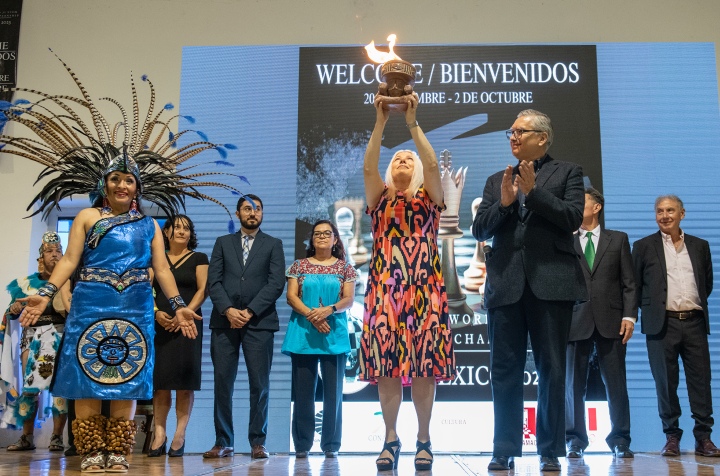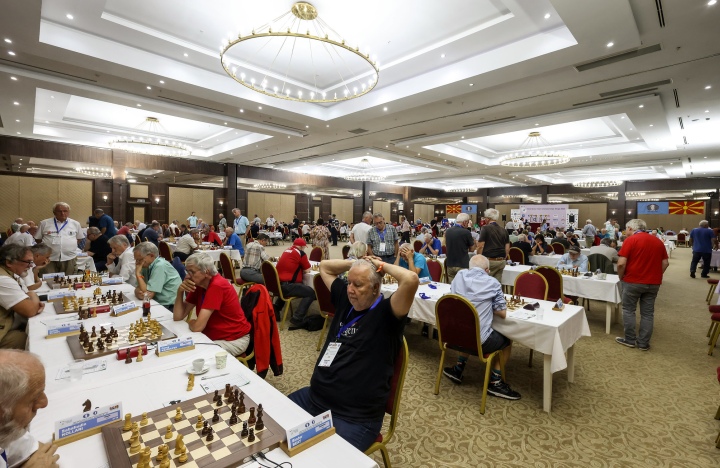FIDE World Junior Championship U20 starts in Mexico City

The President of the National Chess Federation of Mexico, Dr. Mario Antonio Ramírez Barajas, together with representatives of the Mexican Government, special guests and representatives of FIDE, inaugurated the U20 World Junior Chess Championship. The multiple delegations arriving in Mexico City, received the welcoming words of President Mario Ramirez Barajas, President of the National Chess Federation of Mexico. He was joined in the praesidium by the four-time World Women’s Champion Susan Polgar, Erik del Angel Landeros, Coordinator of Technical Council for Diplomacy and Sports Cooperation of the Ministry of Foreign Affairs, Martin Bermudez, Director of the Mexican Olympic Committee, Luis Cámara Patrón, organizer of the “Copa Cámara y Asociados”, Amalia Galvan Trejo, Homero Fernandez Pedroza Director of the Cultural Complex Los Pinos, Carolina Muñoz, Chief Arbiter, Klara Kovac, member of the Fair Play Panel, and Allan Herbert, President of the Appeal Committee. The opening ceremony featured a mariachi music performance, accompanied by a talented folk dance group that did regional dances of Guadalajara, such as the “Son de la Negra” and the famous “Jarabe Tapatío”. “This world-class tournament is very meaningful for all participants of all levels. It is an opportunity and a privilege for Latin America to have a competition of this magnitude in Mexico; it is a sign of confidence and a boost that we must take advantage of to develop our technical level,” said President Mario Ramirez about the importance of this tournament. “We are now watching the future players of the world’s elite. The youngsters who will replace Magnus Carlsen, Hikaru Nakamura and that great group of top players, are in this tournament today. This is a very important additional value for the purposes of the event,” he added. For her part, Susan Polgar added some welcome words, and the event was officially open. It was followed by the ceremony of the Ignition of the Aztec Fire, granted by the Pre-Hispanic Dance Group through a cauldron and a dance. The ceremony, a pact celebrated by the Gods to give life to this world in relation to the position opposite to the first step of the sun through the zenith, symbolized the balance and order of the universe. With the ceremony concluded, President Mario Ramirez invited the players to receive the presents the Organizing Committee had prepared for them. After the opening ceremony, the organizing committee drew the colours and determined the pairings. The top-rated participants, GMs Hans Niemann and IM Carissa Yip, both from the United States, took part in the drawing lots by choosing a Mexican charro who had a white or black piece on their hats. Both top-seed picked the white pieces. Official website: juniorchampionship2023.fide.com Regulations and invitation letter (pdf) Photos: David Llada
FIDE World Senior Team Championship: Day 3 recap

The third round of the FIDE World Senior Team Championship saw the expected clashes of the favourites, and these duels did not disappoint. The top match between North Macedonia Alkaloid and USA started slowly. Georgiev (2542) didn’t achieve anything out of the opening against Kaidanov (2549), and after the latter’s precise execution of the simplifications, a draw was agreed on move 32. The slow start was compensated by the storm on board two in the game between Ehlvest (2530) and Nedev (2465). In the Rossolimo Scicilian, Ehlvest based his preparation on the recent online game between So and Carlsen, but Nedev deviated from Carlsen’s play, and it seemingly caught White by surprise. Soon enough, both players were spending a lot of time calculating and the first critical moment arose on move 12. Instead of the simpler (and superior) 12.Qxd3, Ehlvest got tempted by the attractive 12.e6!? which after 12…fxe6 opened the f-file and prevented Black from castling. However, after 13.Qxd3 b5 14.Bc2 Qh4! it’s amazing how quickly Black’s pieces swarmed the kingside. Black’s next moves were 15…Ne5 (attacking the queen) and 16…Ng4 (threatening mate on h2) and then suddenly, he was creating a mating attack with three pieces. In this position, White had to make a crucial choice. As indicated by Nedev in the live broadcast, the best was to play 17.Nf3 and Black doesn’t have anything more than a perpetual in case of 17…Nf2 18.Kg1 Ng4, or if he wants to continue the game, 17…Qh5 18.h3, leads to an unclear position – here, White’s king is not as weakened as in the game. Ehlvest opted for 17.g3? which was a bad practical choice – the weakness of the white king became a decisive factor. After 17…Qh3 18.Rf4? was another ambitious but wrong move. The same Nf3 mentioned earlier would have limited the damage. After 18…h5 Black was already winning! White has no defence against numerous threats such as …g5, …Bb7, …h4 and …hxg3. The execution was swift. After 19.e5 g5 20.Rf3 h4! White could have resigned as either …hxg3 or …Bb7 was coming. The final position, three moves later, perfectly illustrate the disaster that struck White. Ehlvest resigned. 0-1 It was a flying start for the Macedonian team. On board three, Bogdanovski (2385) had an initiative in the opening against Novikov (2513) but didn’t play precisely, so the game fizzled out to a draw. More drama unfolded on board four. Stanojoski (2351) improvised in the opening against Yermolinsky (2419) and ended up with a knight on the rim and in a bad position. White obtained a dream Catalan position, and in search of complications, Black played 13…Ng4 14.Na4 Bxf2, which was far from even remotely adequate. After 15. Rxf2 Nxf2 16.Kxf2 White was already winning. White quickly consolidated with Be3 and Nc3, while the knight was still stuck on a6. Then the game continued normally, with White even winning the pawn on a7 as Black threw caution to the wind and concentrated on the kingside. The dramatic moment came on move 29. White wasn’t very precise, but he should still win after 29.Rxe5. However, Yermolinsky quickly played his intended 29.h4?? Stanojoski spent two-and-a-half minutes on his move and missed the winning 29…Rxf3! which turns the tables completely. The rook is taboo in view of 30.Bxf3 Nh3, while if the queen escapes, Black plays …Rg3 and …f3 with an easy win. It’s curious that Yermolinsky missed the blow on f3 completely and only found out about it when I told him during the live broadcast! Black took on a3 instead of f3 and after 30.hxg5 White was winning again. There were no more chances for Black in the remainder of the game. The tense match ended 2-2, perhaps a fair result, but these kinds of chances must be taken if a team wants to win an event. On the other hand, it may be a good omen for the Americans, as luck was clearly on their side. England beat Italy 2.5-1.5 thanks to a win by Adams (2662) against David (2523). Adams prepared a recent, but still rare, line against the Taimanov, and the surprised David decided to sacrifice a pawn in search of compensation. Black obtained it, but in the critical moment, he wasn’t up to the challenge. White’s last move was 28.Bf4, preparing g3 or g4. Here Black’s best move was 28…Rh4! preventing 29.g4 in view of 29…Rxg4! 30.Nxg4 Rxg4 31.Kf1 Bg5 and Black regains the material. Perhaps David was worried about 29.g3 but in this case he has 29…f5! (if this is too complicated, the immediate 29…Rxf4 30.Rxf4 Ne2 was a back-up option) 30.exf6 Rxf4! 31.Rxf4 Ne2 32.Kf1 Nxf4 33.gxf4 Bxf6 with a relatively easy draw as White’s pawns on the f-file are weak. Not easy, but to make a draw against a world-class player like Adams, one has to navigate such calculations. David played 28…Rgh8? but after 29.g4, he didn’t have any compensation, and Adams won convincingly. The Italians missed their chance on board four, where Borgo (2333) got a winning advantage against Arkell (2352) after the latter over-extended his position. But the Italian misplayed it and allowed his opponent to simplify the position and draw. The other two games were drawn. Emms (2448) showed excellent preparation to neutralise Godena’s (2429) Alapin Sicilian, while Ortega (2410) defended with precision to extinguish Flear’s (2405) initiative. England is tied for the top position with Iceland that whitewashed Austria. In the S65 section, only two teams managed to keep their 100% score. Germany Lasker Schachstiftung GK ended the dream run of North Macedonia after beating them 3-1. Wins with the white pieces on boards two and four were enough for a convincing win. Meister (2439) maneuvered patiently against Kralevski (2054) in a position where he had two bishops and a queen against a bishop, knight and a queen. Maneuvering is not Kralevski’s strong side and he was gradually outplayed. On board four Trajkovski (1947) badly misplayed the English Opening against Koehler (2189) and couldn’t come back after that. The draw on board one between Ilic (2044) and Knaak (2438) came as a result of mutually cautious play, but on board three Stosevski (1968)

